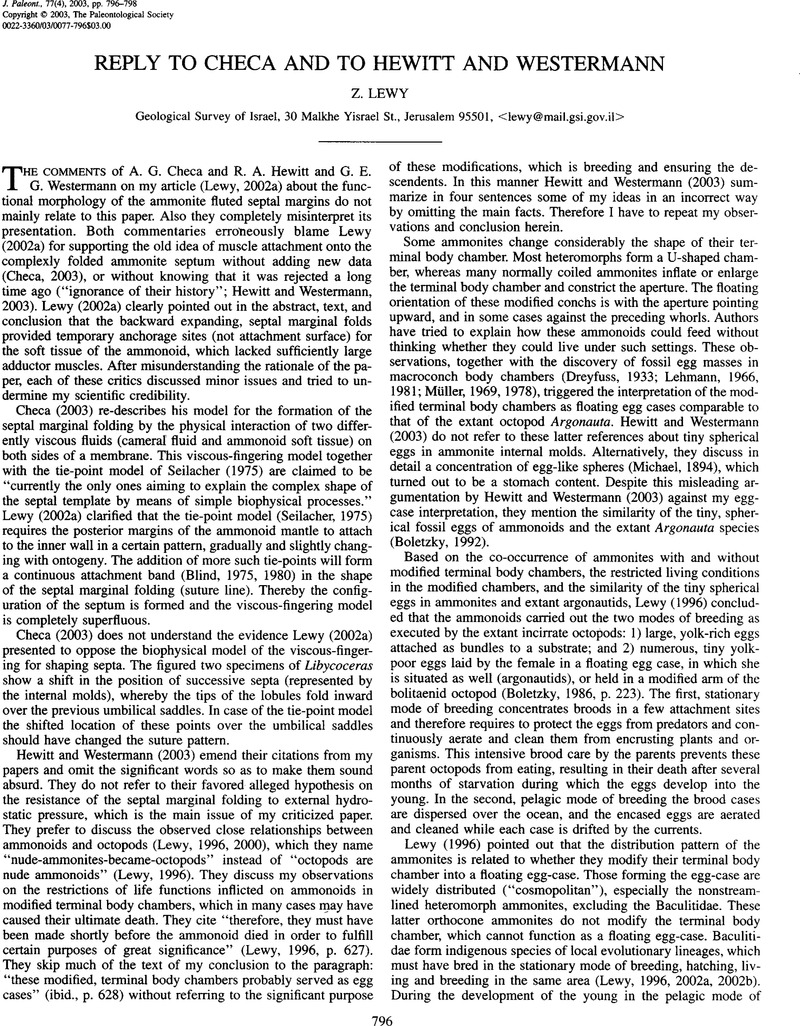No CrossRef data available.
Article contents
Reply to Checa and to Hewitt and Westermann
Published online by Cambridge University Press: 14 July 2015
Abstract
An abstract is not available for this content so a preview has been provided. Please use the Get access link above for information on how to access this content.

- Type
- Comment and Reply
- Information
- Copyright
- Copyright © The Paleontological Society
References
Blind, W.
1975. Über die Entstehung und Funktion der Lobenlinie bei Ammonoideen. Paläontologische Zeitschrift, 49:254–267.CrossRefGoogle Scholar
Blind, W.
1980. Über Anlage und Ausformung von Cephalopoden-Septen. Neues Jahrbuch für Geologie und Paläontologie, Abhandlungen, 160:217–240.Google Scholar
Boletzky, S. V.
1986. Encapsulation of cephalopod embryos: a search for functional correlation. American Malacological Bulletin
4:217–227.Google Scholar
Bucher, H., Landman, N. H., Klofak, S. M., and Guex, J.
1996. Mode and rate of growth in ammonoids, p. 407–461. In
Landman, N. H., Tanabe, K., and Davis, R. A. (eds.), Ammonoid Paleobiology: Topics in Geobiology 13. Plenum Press, New York.CrossRefGoogle Scholar
Checa, A. G.
2003. Fabrication and function of ammonite septa—Comment on Lewy (2002). Journal of Paleontology, 77:790–791.CrossRefGoogle Scholar
Doguzhaeva, L., and Mutvei, H.
1996. Attachment of the body to the shell in ammonoids, p. 43–63. In
Landman, N. H., Tanabe, K., and Davis, R. A. (eds.), Ammonoid Paleobiology: Topics in Geobiology 13. Plenum Press, New York.CrossRefGoogle Scholar
Dreyfuss, M.
1933. Découvrte de nodules phosphates à jeunes Ammonites dans le Toarcien de Créveney (Haute-Saône). Bulletin de la Société Géologique de France, Compte Rendu Sommaire des Séances, 14:224–226.Google Scholar
Fischer, J. C., and Rio, B.
1982. Le plus ancien Octopode connu (Cephalopoda, Dibranchiata): Proteroctopus ribeti nov. gen sp. Du Callovien de l'Ardeche (France). Académie des Sciences, Paris, Compte Rendus des Séances
259:49–52.Google Scholar
Hewitt, R. A., and Westermann, G. E. G.
2003. Recurrences of hypotheses about ammonites and Argonauta
. Journal of Paleontology, 77:792–795.CrossRefGoogle Scholar
Holland, C. H.
1988. The paper nautilus. New Mexico Bureau of Mines & Mineral Resources Memoir
44:109–114.Google Scholar
Landman, N. H.
1985. Preserved ammonitellas of Scaphites (Ammonoidea. Ancyloceratina). American Museum Novitates, 2815:1–10.Google Scholar
Landman, N. H., Cochron, J. K., Chamberlain, J. A. Jr., and Hirschberg, D. J.
1989. Timing of septal formation in two species of Nautilus based on radiometric and aquarium data. Marine Biology, 102:65–72.CrossRefGoogle Scholar
Landman, N. H., Lane, J., Cobban, W. A., Jorgensen, S. D., Kennedy, W. J., and Larson, N. L.
1999. Impressions of the attachment of the soft body to the shell in Late Cretaceous pachydiscid ammonites from the Western Interior of the United States. American Museum Novitates 3273, 31 p.Google Scholar
Lehmann, U.
1966. Dimorphismus bei Ammoniten der Ahrensburger Lias-Geschiebe. Paläontologische Zeitschrift, 41:38–45.CrossRefGoogle Scholar
Lehmann, U.
1981. The Ammonites, Their Life and Their World. Cambridge University Press, Cambridge, 246 p.Google Scholar
Lewy, Z.
1996. Octopods: nude ammonoids that survived the Cretaceous-Tertiary mass extinction. Geology, 24:627–630.2.3.CO;2>CrossRefGoogle Scholar
Lewy, Z.
2000. The erroneous distinction between tetrabranchiate and dibranchiate cephalopods. Acta Geologica Polonica, 50:169–174.Google Scholar
Lewy, Z.
2002a. The function of the ammonite fluted septal margins. Journal of Paleontology, 76:63–69.CrossRefGoogle Scholar
Lewy, Z.
2002b. New aspects in ammonoid mode of life and their distribution. Geobios, 35:130–139.CrossRefGoogle Scholar
Michael, R.
1894. Ammoniten-Brut mit Aptychen in der Wohnkammer von Oppelia steraspis Oppel sp. Zeitschrift der Deutsche Geologische Geselschaft, 46:697–702.Google Scholar
Müller, A. H.
1969. Ammoniten mit ‘Eirbeutel’ und die Frage nach dem Sexualdimorphismus der Ceratiten (Cephalopoda). Deutsche Akademie der Wissenschaften zu Berlin, Monatsberichte, 11:411–420.Google Scholar
Seilacher, A.
1975. Mechanische Simulation und funktionelle Evolution des Ammoniten-Septums. Paläontologische Zeitschrift, 49:268–286.CrossRefGoogle Scholar
Tanabe, K., Shigeta, Y., and Mapes, R. H.
1995. Early life history of Carboniferous ammonoids inferred from analysis of shell hydrostatics and fossil assemblages. Palaios, 10:80–86.CrossRefGoogle Scholar
Westermann, G. E. G.
1975. Model for origin, function and fabrication of fluted cephalopod septa. Paläontologische Zeitschrift, 49:235–253.CrossRefGoogle Scholar




